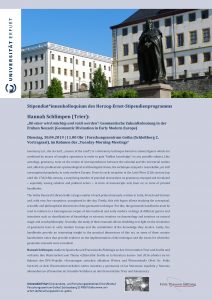Am Dienstag, den 30. April 2019 um 11:00 Uhr, hält Hanna Schlimpen (Trier) im Rahmen des „Tuesday Morning Meetings“ einen Vortrag über „‚Ob einer wird mächtig und reich werden‚: Geomantische Zukunftsdeutung in der Frühen Neuzeit (Geomantic Divination in Early Modern Europe)“. Der Vortrag findet im Vortragsaal des Forschungszentrums Gotha am Schloßberg 2 statt.
Abstract
Geomancy (ar. ‚ilm al-raml‘, „science of the sand“) is a divinatory technique based on sixteen figures which are combined by means of complex operations in order to gain “hidden knowledge” on any possible subject. Like astrology, geo mancy rests on the notion of correspondences between the celestial and the terrestrial realms and, albeit its problematic epistemological and theological status, the technique enjoyed a remarkable, yet still unrecognized popularity in early modern Europe. From its early reception in the Latin West (12th century) up until the 17th/18th century, a surprising number of practical instructions on geomancy emerged and circulated – especially among scholars and political actors – in form of manuscripts and, later on, in form of printed handbooks.
mancy rests on the notion of correspondences between the celestial and the terrestrial realms and, albeit its problematic epistemological and theological status, the technique enjoyed a remarkable, yet still unrecognized popularity in early modern Europe. From its early reception in the Latin West (12th century) up until the 17th/18th century, a surprising number of practical instructions on geomancy emerged and circulated – especially among scholars and political actors – in form of manuscripts and, later on, in form of printed handbooks.
The Gotha Research Library holds a large number of such printed manuals, written in Latin, French and German and, with very few exceptions, unexplored to this day. Firstly, this rich legacy allows studying the conceptual, scientific and philosophical dimensions of the geomantic technique. For this, the geomantic handbooks must be read in relation to a heterogenous corpus of late medieval and early modern writings of different genres and intentions such as classifications of knowledge or sciences, treatises on demonology and treatises on natural magic and occult philosophy. Secondly, the study of these manuals allows shedding new light on the circulation of geomantic texts in early modern Europe and the assimilation of the knowledge they involve. Lastly, the handbooks provide an interesting insight in the practical dimensions of this art, as some of them contain handwritten notes that provide evidence on the implementation of the technique and the issues for which the geomantic manuals were consulted.
